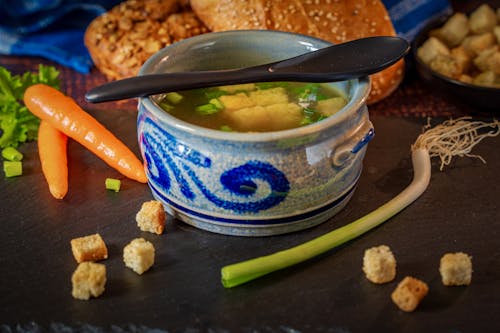Many cultures around the world enjoy soup for breakfast, each with its unique flavors and ingredients. Here are a few examples:
-
Vietnam: Pho is a popular breakfast soup made with rice noodles, herbs, vegetables and various meats, usually beef or chicken. It’s often served with lime, bean sprouts, and chili. It can also be made vegan.
-
Korea: Juk, or rice porridge, is a common breakfast dish. It can be savory or sweet and is often served with side dishes. Another popular soup is kimchi jjigae, a spicy stew made with kimchi and tofu.
-
China: Congee, a rice porridge, is frequently consumed for breakfast. It can be topped with a variety of ingredients like pickled vegetables, meat, or century eggs. They served plain vegetarian congee at the buffet on the cruise ship we took last summer.
-
Japan: Miso soup is often part of a traditional Japanese breakfast, served alongside rice or with noodles.
-
Mexico: Caldo de pollo, a chicken soup, is frequently eaten for breakfast, often accompanied by tortillas and lime.
-
Philippines: Arroz caldo is a rice porridge with chicken and ginger, typically served with toppings like hard-boiled eggs and green onions.

These soups often reflect local ingredients and culinary traditions, making breakfast a hearty and flavorful meal in these cultures.
My Morning Miso Soup
My morning miso broth vegetable soup is made vegetables that I already have in the fridge, meaning the recipe is flexible and you can substitute other vegetables such as Bok choy, spinach or cabbage instead of the exact greens that I used.
What is Miso and Why it is a Healthy Food?
 |
| Miso paste |
Miso is a traditional Japanese fermented paste made primarily from soybeans, salt, and a koji culture (Aspergillus oryzae). It can also include or be made from other grains such as rice or barley. Miso varies in flavor, color, and texture depending on the ingredients and fermentation time, ranging from sweet and mild to salty and robust.
I buy miso at Whole Foods or Asian food markets
Miso can be found in the refrigerator case and will keep at home for many months in the refrigerator (even up to a year). Do not freeze miso.
I make sure that my miso is gluten-free, as miso can sometimes be fermented with barley (which is not gluten-free) so always check for a certified gluten-free brand to avoid cross contamination.
Nutritional Benefits of Miso:
-
Protein Source: Miso adds some plant-based protein (about 2.2 grams/tablespoon) to the soup.
-
Probiotics: Being a fermented food, miso contains beneficial probiotics that can support gut health and digestion.
-
Vitamins and Minerals: Miso is rich in essential nutrients, including vitamins B, E, K, and minerals like manganese, copper, and zinc.
-
Antioxidants: Miso contains antioxidants that can help combat oxidative stress in the body.
-
Low in Calories: It is generally low in calories, making it a flavorful way to enhance dishes without adding significant calories.
-
May Support Immune Function: Some studies suggest that the probiotics and nutrients in miso can support immune health.
Considerations:
While miso is nutritious, it can be high in sodium, so it’s best consumed in moderation, especially for those monitoring their salt intake.
 |
| My miso soup with zucchini spiral noodles |
Soup Ingredients:
6 cups of water
1 cup of vegetable broth
1 cup of sliced celery
1 cup of sliced carrots
1/2 cup of diced zucchini
3 large mushrooms, sliced (any kind- I used white)
1 cup of curly kale or baby kale, chopped
1 teaspoon of freshly grated organic ginger
1/4 teaspoon of turmeric
Cracked pepper to taste (miso is salty so you won’t need salt)
2 tablespoons of miso paste ( Use less for less salty flavor)
Directions:
Add celery, carrots, zucchini, ginger, mushrooms and liquids to a soup pot. Bring to a boil and then simmer for 4 minutes. Add mushrooms and kale and simmer for an additional 4 minutes. When done, (and all vegetables are cooked) turn off the flame. Add miso according to the following directions and enjoy immediately.
How to add miso paste to soup so it does not destroy the health benefits
Use a small mesh colander and make sure the heat is off.
1. Place 2 tablespoons of miso paste into a small fine mesh colander.
2. Place the colander into the soup
3. Using the back of a tablespoon, rub the miso paste through the mesh colander into the soup. Stir
Other Ways to Use Miso:
Miso imparts that Unami flavor and it can be used in a variety of ways. It doesn’t need cooking so it can be used as an additional flavor in:
- salad dressings
- marinades
- glazes for sweet potatoes or eggplant
- sauces
My Notes:
- If you plan to make the soup in advance, add the miso last minute prior to consuming. Boiling Miso destroys its benefits.
- Never heat or cook miso; always add it last to preserve nutrients
- As you can see from my soup photos, this simple soup broth can be eaten with cooked rice noodles or even zucchini spiral noodles for a heartier meal.
 |
| spiraled zucchini noodles to add to soup |
Have you ever had soup for breakfast? What is your favorite breakfast?

